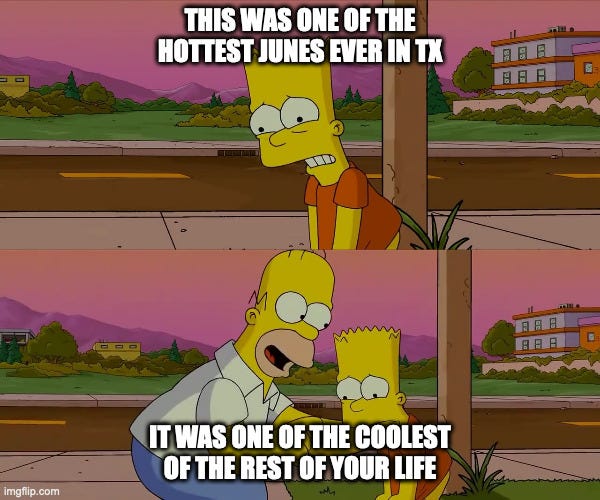How hot was Texas in June?
TL;DR: very hot
As this interminable summer drags on, Texas has already recorded some significant climatic milestones. In particular, June saw a rash of record-breaking temperatures across the state, primarily in the west-central and southern regions.
The following stats were compiled and analyzed by the Southeast Regional Climate Center, which is run by my colleague John Nielsen-Gammon, using NCEI data.
Texas records during June
8 stations recorded all-time maximum temperatures:

includes data through June 27 6 additional stations recorded maximum June temperatures
4 stations recorded summertime hottest daily minimum temperature:

includes data through June 27 8 additional stations recorded June hottest daily minimum temperature
Statistics for June
Number of days above 100F: Corpus Christi broke it’s record, most other stations in the southern half of the State were top 10.
The monthly average temperature was generally top 5 in southern third of the State, including #1 in Corpus Christi, Del Rio, Brownsville. Dalhart, in the Texas panhandle, had its 8th coldest June.
The last two weeks of June were generally the hottest on record for the southern half of Texas; top ten for much of northern half
Why?
You know why.
OK, here are a few more details. The oceans are 2-4F warmer than average. This is due, at least in part, to climate change.
In addition to a generally warmer environment, you also need the right “flow pattern” to get a heatwave. The atmospheric flow pattern in the second half of June featured what Nielsen-Gammon called an “angry-looking upper-level ridge”:
The plot shows a high-pressure system parked over Mexico (the “H” in the figure). I’ve previously written about the meteorology of extreme heat and how heat waves are associated with high pressure; based on the position of the high, you can see that the heatwave was mainly focused on Mexico. But it extended into south Texas, which is why it was so hot there.
Was this particular flow pattern connected to climate change? Hard to say at this point, although future research might reveal a connection. See my colleague R. Saravanan’s substack for a deeper dive into this question.
Nevertheless, we can say with confidence that climate change is making this heatwave worse, although quantification of this statement will have to wait for detailed attribution studies.
In the absences of detailed attribution studies of this event, a reasonable rule of thumb is that climate change made this heatwave 1-3C (2-5F) warmer than it would have otherwise been.
The upshot
Some people will look at this and say, “It’s summer in Texas, what did you expect?” Based on the historical temperature record, I expected a cooler June. But the enduring lesson of climate change is that we should adjust our expectations for a hotter and more miserable future of extreme heat.





I've had 60 summers in Texas and this one is NOT normal. Last year wasn't either. Hasn't been normal for several years. I can easily tell because the planting seasons aren't what they used to be. We know how to live with heat and humidity but this is next level now. We don't usually have people dropping dead left and right who misjudged the humidity part of this heat. We've had mail carriers, hikers, and elderly, among others, dying this summer because this is super dangerous heat.
It's tragic and unsettling, and we have a real prisoner's dilemma in air conditioning use ahead of us... but we have to get through this. Chat GPT, halp!